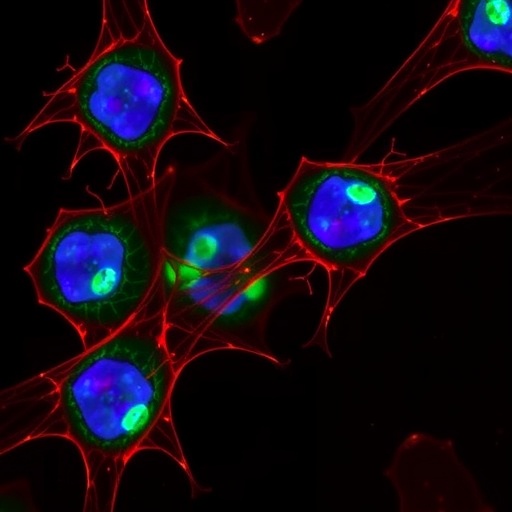In a groundbreaking study published in Nature, researchers have uncovered the intricate roles of two transcription factors, TCF1 and LEF1, in the development and maintenance of B-1a cells, a critical subset of the immune system. Utilizing cutting-edge single-cell RNA sequencing across various developmental stages, the team delineated how these factors uniquely and cooperatively regulate pathways crucial for B-1a cell maturation and homeostasis.
The investigation began with the isolation and profiling of four distinct B-1 developmental stages: fetal liver B-1 progenitors, adult bone marrow B-1 progenitors, peritoneal cavity B-1 cells, and splenic B-1 cells. By applying trajectory analysis to this comprehensive dataset, researchers discerned a continuous developmental path beginning with fetal liver progenitors and culminating in mature peripheral B-1 cells. Notably, splenic and peritoneal B-1 cells clustered near the mature end of the trajectory, highlighting their advanced differentiation state.
Importantly, a small subset of splenic and peritoneal cavity B-1 cells localized within the fetal liver progenitor cluster, providing compelling evidence for the existence of splenic B-1a precursors. This finding challenges previous paradigms that predominantly situated B-1 progenitors within hepatic or bone marrow niches, underscoring the dynamic nature of B-1a cell ontogeny.
Expression analyses revealed contrasting patterns for Lef1 and Tcf7 (encoding LEF1 and TCF1, respectively). Lef1 was robustly expressed in B-1 progenitors derived from both fetal liver and bone marrow, with expression levels waning in peripheral mature B-1 cells. Conversely, Tcf7 expression was minimal in progenitor populations but escalated significantly in splenic and peritoneal cavity B-1 cells. This reciprocal expression suggests temporally distinct roles for these transcription factors during B-1 cell development.
Further characterization of gene expression patterns elucidated molecules intimately associated with B-1 cell ontogeny. Fetal B-1 progenitors prominently expressed Lin28b, Arid3a, and Il7r, genes previously implicated in lymphoid development and progenitor maintenance. Bone marrow progenitors exhibited elevated Bhlhe41 expression, which intensified in mature splenic and peritoneal B-1 cell populations. Mature B-1 cells also uniquely expressed Ctla4 and Bmi1, genes linked to immune regulation and cellular longevity.
Functional interrogation of signaling pathways illuminated distinct consequences of LEF1 and TCF1 deficiencies. Loss of LEF1 perturbed the IL-6–STAT3, TGFβ, and TNF signaling cascades, pathways integral to inflammation and cellular communication. In contrast, TCF1 deficiency principally disrupted cell cycle processes, notably the regulation of E2F targets and G2–M phase checkpoints, indicating a pivotal role for TCF1 in controlling B-1 cell proliferation. Strikingly, deficiencies in either transcription factor converged on dysregulation of the IL-2–STAT5 signaling pathway, underscoring IL-2 signaling as a shared and essential axis for B-1a cell function.
Reanalysis of a comprehensive human prenatal single-cell atlas revealed parallel expression patterns. Cells expressing classical mouse B-1a markers such as CD5 and SPN (encoding CD43) consistently co-expressed TCF1 and LEF1. Those co-expressing both transcription factors exhibited heightened expression of CD5, SPN, IL2RG, and IL7RA compared to cells expressing either factor alone. This conserved signature implicates TCF1 and LEF1 as crucial regulators not only in mouse but also in human B-1 cell biology.
Intriguingly, human progenitor B cells, including the ProB subset known for proliferative capacity, also expressed TCF1 and LEF1, mirroring observations in mice. This was corroborated by MKI67 expression, a well-established marker of cellular proliferation, which appeared prominently in cycling B cells co-expressing these transcription factors. Such findings align with the concept that TCF1 and LEF1 orchestrate developmental and proliferative programs in early B-lineage cells.
Given the centrality of IL-2 signaling downstream of TCF1 and LEF1, the research investigated B-1-like populations in human patients with severe combined immunodeficiency (SCID) attributed to mutations in IL2RG (IL-2 receptor gamma chain) and IL7RA (IL-7 receptor alpha chain). Remarkably, pediatric patients harboring IL-2Rγ deficiency exhibited an approximate 80% reduction in circulating B-1-like cells compared to healthy controls. This stark reduction underscores the indispensable nature of IL-2Rγ-mediated signaling for human B-1 cell maintenance.
Nonetheless, the authors caution that age disparities between patients (median 6 years) and healthy donors (median 24 years), coupled with evidence that adult mice possess twice as many B-1a cells as their juvenile counterparts, warrant further investigation before definitive causal relationships can be established in humans. Such nuances exemplify the complexity underlying immunological development and phenotypic variation.
This study’s revelations advance our understanding of B-1a cell biology by assigning precise molecular functions to TCF1 and LEF1, illuminating previously uncharted territory in immune regulation. The elucidation of signaling pathways, transcriptional circuits, and developmental trajectories marks a significant leap toward therapeutic manipulation of B-1 cells, which are implicated in immunity against pathogens and in autoimmunity.
Future research avenues may explore how modulation of TCF1 and LEF1 activity influences B-1 cell responses during infections and autoimmune conditions. Additionally, given the parallels between mouse and human systems, therapeutic targeting of IL-2 and IL-7 receptor pathways may hold promise for correcting B-1 cell deficiencies in immunodeficiencies or harnessing their regulatory properties.
In sum, this comprehensive work elegantly integrates developmental immunology, molecular genetics, and single-cell transcriptomics to reveal a finely tuned regulatory network governing B-1a cell homeostasis. The cross-species conservation of these mechanisms highlights the evolutionary significance of TCF1 and LEF1 and their potential as key nodes in immune modulation strategies.
Subject of Research: Roles of transcription factors TCF1 and LEF1 in B-1a cell development, homeostasis, and signaling pathways.
Article Title: TCF1 and LEF1 promote B-1a cell homeostasis and regulatory function.
Article References:
Shen, Q., Wang, H., Roco, J.A. et al. TCF1 and LEF1 promote B-1a cell homeostasis and regulatory function. Nature (2025). https://doi.org/10.1038/s41586-025-09421-0
Image Credits: AI Generated




